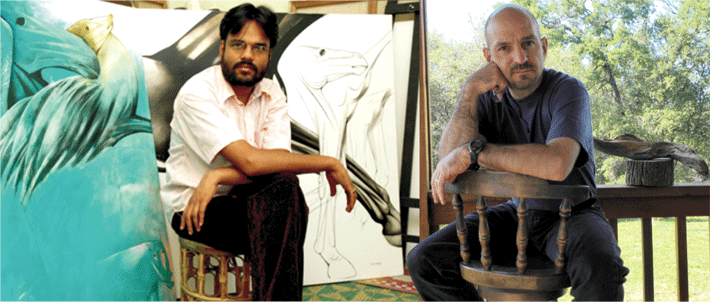- Guest Editor’s Column
- Docedge the Asian documentary forum
- Creative Impulse
- Arts and Crafts Movement : Mission Style Furniture
- Porcelain-enamel Advertising Signs
- Passions run high over the auction of Tagore's paintings
- In the News
- Controversy
- Artist Index and Statistics
- Market Insight
- Auction Reports : What happened
- Auction Reports : what's forthcoming
- Art's eye-view
- The month that was
- Mumbai Artsighting
- Art Bengaluru
- Musings from Chennai
- Deccan Odyssey
- North-East Opsis
- The Wreckage
- Inscription in Bronze
- Black and White
- Nature God
- Indian Highway
- Structures Within an Intervention
- Hard Talk
- Different hues of Aakriti
- Christie’s : Important Watches
ART news & views
Hard Talk
Volume: 2 Issue No: 5 Month: 6 Year: 2010

Crossing Over
|
One is an Indian artist whose past work resonating with detailed anatomical animal and human studies won him accolades in just a few years, the other an American artist whose large-scale installations can even double up as performance art! Bridging the geographical and cultural barriers that separate the two artists, Amitesh Verma (New Delhi) and Andrew Connelly (California, USA) collaborate for a two-man show titled Crossing Over that begins at Shridharani Gallery, Triveni Kala Sangam, 205, Tansen Marg, New Delhi, from June 15 to June 25, 2010. Here is an interesting tête-à-tête between the two. |
Amitesh Verma (AV): Andrew, are you looking forward to your first exhibition in India?
Andrew Connelly (AC): I have spent a lot of time in a residency at Sanskriti Kendra in Delhi and the most natural thing was to have a show inspired by that influence. You yourself are back from a residency in France, aren't you?
AV: Yes, I was part of a three-month residency at Marnay-Sur-Seine in France in November last year. And like you, my work is completely inspired by that experience. I have always portrayed the spirituality inherent in each one of us, whether in the portraits of people or animal figures, especially those majestic horses I have observed for hours sitting at Race Course in Delhi. I think the French sojourn was a sort of a spiritual arousal for me and gave me a new insight into how I looked at people as subjects. Tell me, what made you choose bamboo as the medium for your work?
AC: I made a similar form in my studio back home out of solid laminated wood and I wanted see the same form in woven Bamboo. The original wood form looks so dense, I wanted to see a contrast, a translucency to the form. Bamboo is also a material associated with the developing world. Unlike the US, it is used for so many applications such as scaffolding and furniture. So, many of my choices I made while making work in India was to observe and embrace the contrasting cultures and approaches to all things.
AV: That's precisely what I feel about my work too. Despite severe language and cultural differences, I forged very close relationships with people I met in France, one of them, a young blonde girl, is the muse for my work titled My Crush.
AC: But you have not moved away from your previous technique, I have followed the strong anatomical lines in your work on horses and human forms.
AV: Yes, drawings have always been my first love. There are several pencil and charcoal drawings in this show as well. I will always give my guru and eminent artist Neeraj Goswami the credit for inculcating in me the love for drawings. But (drawings) have changed greatly over the last two years and my work I feel is more evolved. Earlier my studies used to look more like still life but now I think I have come much closer to the abstraction in form that I was seeking for so long. Your work is abstract too in its own way.
AC: You are talking about Transcendence. It's a bamboo structure rooted in the earth and yet carrying an embodied lightness as it appears to reach towards the sky, becoming fluid like water as it travels, transforms and disappears. The abstract form certainly lends itself to interpretation and I enjoy the ambiguity. Being a 'transcendent' performance, the form itself exists in transition, defining space only by means of a bamboo-line while light passes through, yet its presence can not be denied.
AV: But water is also a continuous element in your work.
AC: We all have personal connections to water, whether it is the clear substance that comes out of the tap, a murky pond, or deep ocean, not to mention our physical makeup. I grew up with a healthy respect for water both swimming and fishing in the waters around New York. Its memories and personal connections evoke both a passion to breathe ocean breezes and to fear its fury during storms and floods. It would be interesting to see how the audience reacts to our collaboration.
AV: I think the important thing is that while my new work imbibes a European sensibility, it retains my Indian roots, while yours has the same sensitivity to Indian social and cultural ethos. I particularly like your work with photographs.
AC: You were telling me about this French woman who met you at a railway station and how her entire demeanor immediately warmed you up to her. I sensed the same feeling of warmth during my residency here. The photographs are structured to observe the social strata in India and are mostly of the male workers from the Sanskriti Kendra ranging from kitchen help, landscapers to security.
AV: Thanks Andrew, it has been a pleasure talking to you and having you here for our show in June.
AC: Thanks. I look forward to it as well.
Poonam Goel